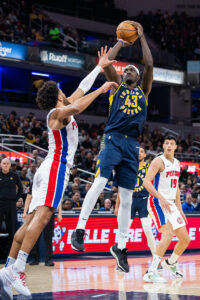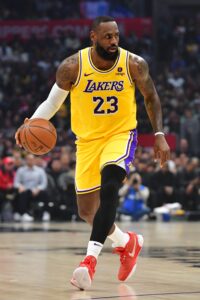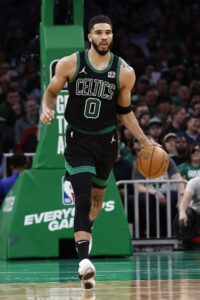The NBA has no shortage of rules affecting which players can and can’t be traded at any given time, which complicates our understanding of which players are actually moveable. That’s especially true leading up to the regular season, when players who recently signed free agent contracts, extensions, and rookie contracts all face different sets of trade restrictions.
In an effort to clear things up, we’re looking today at which players around the NBA are currently affected by trade restrictions of one kind or another. Let’s dive in…
Recently signed free agents
In most cases, a free agent who signed a contract in the offseason is ineligible to be traded until December 15.
 Currently, our list of players who will become trade-eligible on December 15 features 85 names, including several of the guys who signed the biggest free agent contracts of the summer, such as Paul George, Pascal Siakam, and Isaiah Hartenstein.
Currently, our list of players who will become trade-eligible on December 15 features 85 names, including several of the guys who signed the biggest free agent contracts of the summer, such as Paul George, Pascal Siakam, and Isaiah Hartenstein.
But the list is technically even longer than that, since we haven’t included players who signed non-guaranteed Exhibit 10 contracts. Most of those players will be waived by opening night, but if they earn spots on regular season rosters, the December 15 trade restriction would apply to them as well.
A free agent who signs after September 15 won’t become trade-eligible until three months after his signing date.
Any player who has his two-way contract converted to a standard deal during the offseason also doesn’t become trade-eligible until December 15 or until three months after the move, whichever comes later. However, no players were promoted from two-way contracts to standard deals this summer. All the players who finished last season on two-ways either became free agents on July 1, were waived, or are still on their previous contracts.
A select group of players who signed free agent contracts this offseason won’t become trade-eligible until January 15. These 16 players all meet a specific set of criteria. Not only did they re-sign with their previous team this offseason, but they got a raise of at least 20%, their salary is worth more than the minimum, and their team was over the cap, using Bird or Early Bird rights to sign them. That group includes Tyrese Maxey, Immanuel Quickley, and Nic Claxton, among others.
The above rules apply to players who sign standard contracts, not two-way deals. A player who signs a two-way contract is ineligible to be traded for 30 days. So Luke Travers, who signed with the Cavaliers on August 28, will become trade-eligible on September 27. Two-way players are almost never traded, but it happens every now and then, like when RaiQuan Gray was included in this summer’s three-team DeMar DeRozan sign-and-trade.
Recently signed draft picks
Like a player who signs a two-way contract, a draftee who signs his first NBA contract is ineligible to be traded for 30 days. Currently, this restriction only impacts Jazz second-rounder Kyle Filipowski, who signed a four-year contract on August 12 and will become trade-eligible on September 11.
The rest of this year’s draftees can currently be traded.
That list of tradable 2024 draftees includes all the players besides Fililpowski who have signed, since more than 30 days have passed since their officially completed their deals.
It also includes the two players who remain unsigned – Nikola Djurisic and Quinten Post – since their draft rights can be traded until they sign their contract. If Djurisic and Post officially sign NBA contracts for 2024/25, they’ll become trade-ineligible for 30 days.
Players with veto ability
Suns guard Bradley Beal and Lakers forward LeBron James are the only NBA players who have genuine no-trade clauses in their contracts, but several other players have the ability to veto trades this season due to various quirks of the Collective Bargaining Agreement.
Clippers guard James Harden, Grizzlies sharpshooter Luke Kennard, Sixers guard Kyle Lowry, and Nuggets center DeAndre Jordan are some of the notable players whose consent will be required to trade them during the 2024/25 season.
Under the new CBA, a player who would normally meet the no-trade criteria due to re-signing with his current team on a one-year contract (or a two-year deal with a second-year option) can opt to waive his right to veto a trade.
Eleven players have done so this season, including Knicks big man Precious Achiuwa and Sixers forward Kelly Oubre, so once they become trade-eligible (on either December 15 or January 15), they can be moved without any issue.
Players who have signed veteran extensions
A player who signs a rookie scale extension becomes more difficult to trade due to the “poison pill provision,” but he could theoretically be moved immediately.
That’s not necessarily the case for a player who signs a veteran contract extension. A player who signs a veteran extension becomes ineligible to be traded for the next six months if the deal locks him up for more than four total years (including his current contract), includes a first-year bump higher than 20%, and/or includes a raise exceeding 5% anytime after the first year of the extension.
With the help of our extension trackers, here are the players currently affected by that rule, along with the dates they’ll become trade-eligible:
- October 11: Jrue Holiday (Celtics)
- October 16: Grayson Allen (Suns)
- January 6: Bam Adebayo (Heat), Jonathan Isaac (Magic), Derrick White (Celtics)
- January 7: Donovan Mitchell (Cavaliers)
- January 12: Jalen Brunson (Knicks)
- January 23: Sam Hauser (Celtics)
- January 26: Andrew Nembhard (Pacers)
- February 2: Jarrett Allen (Cavaliers)
- February 7: Lauri Markkanen (Jazz)
- March 3: T.J. McConnell (Pacers), Ivica Zubac (Clippers)
Since the trade deadline will land on February 6, Markkanen, McConnell, and Zubac won’t be eligible to be traded until the 2025 offseason.
This restriction will also apply to any player who signs an extension meeting the terms outlined above between now and the trade deadline, such as Jamal Murray, who has reportedly agreed to terms on a new four-year extension with the Nuggets.
Warriors star Stephen Curry and Wizards big man Richaun Holmes also signed extensions this offseason, but those deals didn’t exceed four total years or include raises greater than 5%, meaning Curry and Holmes remain eligible to be traded. Obviously, that’s a far more realistic outcome for Holmes than Curry.
Players who have signed Designated Veteran extensions
A Designated Veteran contract is also known as a “super-max” deal — it’s a maximum-salary contract that starts at 35% of the cap instead of 30% because the player has met certain performance criteria before achieving 10 years of NBA service.
A player who signs a Designated Veteran contract or extension can’t be traded for one full year after his signing date.
Only one player has signed a super-max contract this offeason: Celtics forward Jayson Tatum. He’ll become trade-eligible on July 6, 2025, the one-year anniversary of his signing.
Players affected by aggregation restrictions
When a team trades for a player via salary-matching or using an exception (ie. not by absorbing the player into cap room), that team can’t “aggregate” the player in another trade for two months. Aggregating a player means combining his salary with another player’s for matching purposes.
The majority of the trades made this offseason so far were completed before July 9, so this restriction only applies to two players at the moment. Here are those players, along with the dates when they’ll become aggregation-eligible:
- September 19: Ziaire Williams (Nets)
- September 29: David Roddy (Hawks)
Any player who is traded this season after December 16 (without being acquired via cap room) won’t be eligible to be flipped prior to the trade deadline in a second deal that aggregates his salary with another player’s.
This aggregation restriction also applies indefinitely to any player on a team who is operating over the second tax apron. Currently, four teams fit that bill: the Suns, Celtics, Bucks, and Timberwolves.
